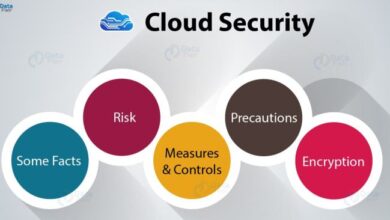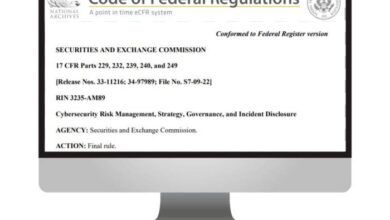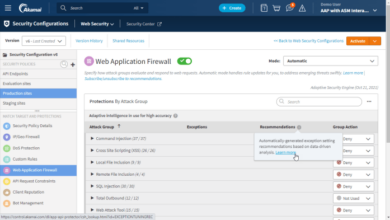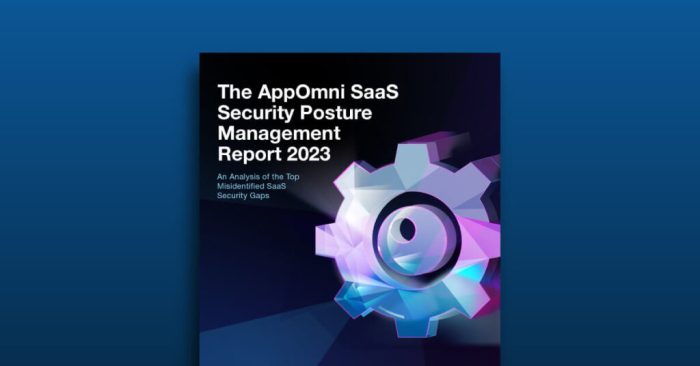
AppOmni SaaS Security Report: Securing Your Cloud Applications
The AppOmni SaaS Security Report delves into the critical world of securing cloud applications, a landscape that’s evolving at an unprecedented pace. This report isn’t just about technical jargon; it’s about understanding the vulnerabilities that lurk within your SaaS applications and how to mitigate them.
From identifying the latest threats to outlining best practices, this report serves as a comprehensive guide for navigating the complexities of SaaS security.
The report examines the challenges faced by businesses and organizations in protecting their sensitive data and systems housed within SaaS applications. It explores how AppOmni, a leading SaaS security platform, addresses these challenges with its innovative approach to security. The report also provides real-world examples of how AppOmni can be deployed to secure specific SaaS applications, offering practical insights for organizations looking to bolster their security posture.
Introduction to AppOmni SaaS Security

The world of business is increasingly reliant on Software-as-a-Service (SaaS) applications. From email and collaboration tools to customer relationship management (CRM) and financial software, SaaS applications have become essential for organizations of all sizes. This reliance on SaaS applications, however, presents a significant challenge: securing these applications and the sensitive data they contain.
SaaS Security Challenges
SaaS security poses unique challenges that traditional security approaches may not effectively address. These challenges stem from the shared nature of SaaS applications, where multiple tenants share the same infrastructure and applications. This shared environment creates a higher risk of data breaches and security vulnerabilities.
- Shared Infrastructure:SaaS providers manage the infrastructure, making it difficult for organizations to control security settings and configurations.
- Data Visibility and Control:Organizations often lack visibility into their data stored within SaaS applications, making it challenging to identify and mitigate risks.
- Third-Party Risks:SaaS providers rely on third-party vendors for various services, introducing additional security risks.
- Rapidly Evolving Threat Landscape:The threat landscape for SaaS applications is constantly evolving, with new vulnerabilities and attack vectors emerging regularly.
AppOmni: A Solution for SaaS Security
AppOmni addresses these challenges by providing a comprehensive SaaS security platform. AppOmni’s solution empowers organizations to secure their SaaS applications and data by providing:
- Visibility and Control:AppOmni offers deep visibility into SaaS applications, enabling organizations to identify and manage security risks.
- Threat Detection and Response:AppOmni provides advanced threat detection and response capabilities to proactively identify and mitigate security threats.
- Data Security and Compliance:AppOmni helps organizations ensure data security and compliance with industry regulations such as GDPR and HIPAA.
- Automated Security:AppOmni automates security tasks, reducing the burden on security teams and enabling them to focus on strategic initiatives.
AppOmni’s Approach to SaaS Security
AppOmni takes a comprehensive approach to SaaS security, focusing on securing the data and applications within the cloud. It provides a platform that integrates with various SaaS applications, enabling organizations to manage and control access, monitor activity, and detect threats.
AppOmni’s Core Features and Functionalities
AppOmni offers a suite of features that cover various aspects of SaaS security. These features are designed to address the challenges associated with securing SaaS applications and data.
The AppOmni SaaS security report highlights the growing vulnerabilities within cloud applications, emphasizing the need for robust security measures. It’s interesting to see how the tech world is simultaneously advancing in areas like AI, as evidenced by Google’s impressive new Gemini conversational AI capabilities, which are making Apple’s Siri look increasingly outdated.
This rapid development in AI could potentially be used to bolster SaaS security solutions, ultimately benefiting the findings outlined in the AppOmni report.
- SaaS Security Posture Management (SSPM):This feature helps organizations assess their SaaS security posture by identifying misconfigurations, vulnerabilities, and risks. It provides insights into the security of their SaaS applications and helps them prioritize remediation efforts.
- Data Security and Governance:AppOmni allows organizations to control access to sensitive data stored within SaaS applications. It provides granular access controls, data masking, and encryption capabilities to protect sensitive information.
- Threat Detection and Response:AppOmni monitors SaaS applications for suspicious activities and potential threats. It uses machine learning algorithms to detect anomalies and alert security teams about potential breaches. It also provides tools for incident response and investigation.
- SaaS Compliance and Audit:AppOmni helps organizations comply with relevant security regulations and standards. It provides tools for auditing and reporting on SaaS security controls and data access activities.
- SaaS Security Automation:AppOmni offers automation capabilities to streamline security tasks and reduce the manual effort required for managing SaaS security. It provides tools for automating security policies, workflows, and reporting.
Addressing SaaS Security Challenges
AppOmni’s approach to SaaS security addresses several key challenges faced by organizations:
- Data Security in the Cloud:SaaS applications often store sensitive data, making it crucial to protect it from unauthorized access and breaches. AppOmni provides data security controls, such as access control, data masking, and encryption, to secure sensitive information.
- SaaS Application Misconfigurations:Misconfigured SaaS applications can create vulnerabilities that expose sensitive data or compromise security. AppOmni’s SSPM feature helps organizations identify and remediate these misconfigurations, improving the overall security posture of their SaaS applications.
- SaaS Application Vulnerabilities:SaaS applications are not immune to vulnerabilities, which can be exploited by attackers to gain unauthorized access or steal data. AppOmni provides vulnerability management capabilities to identify and patch vulnerabilities, reducing the risk of exploitation.
- Lack of Visibility and Control:Organizations often lack visibility into the activities happening within their SaaS applications, making it difficult to detect and respond to threats. AppOmni provides comprehensive monitoring and logging capabilities, giving organizations visibility into user activity, data access, and potential threats.
- SaaS Security Complexity:Managing security across multiple SaaS applications can be complex and time-consuming. AppOmni simplifies SaaS security by providing a centralized platform for managing security policies, monitoring activities, and responding to threats.
Implementation Examples
- Securing Salesforce Data:AppOmni can be implemented to secure sensitive data stored in Salesforce, such as customer information, financial data, and intellectual property. It can enforce access controls, monitor user activity, and detect suspicious activity to prevent data breaches.
- Protecting Microsoft 365 Environment:AppOmni can be used to secure Microsoft 365 applications, including Exchange Online, SharePoint Online, and OneDrive. It can help organizations control access to sensitive emails, documents, and files, and detect malicious activity, such as phishing attacks and data exfiltration attempts.
- Enhancing Security for Google Workspace:AppOmni can be integrated with Google Workspace to secure data stored in Gmail, Drive, and other applications. It can enforce access controls, monitor user activity, and detect threats, such as unauthorized access attempts and data leaks.
Key Findings of the AppOmni SaaS Security Report
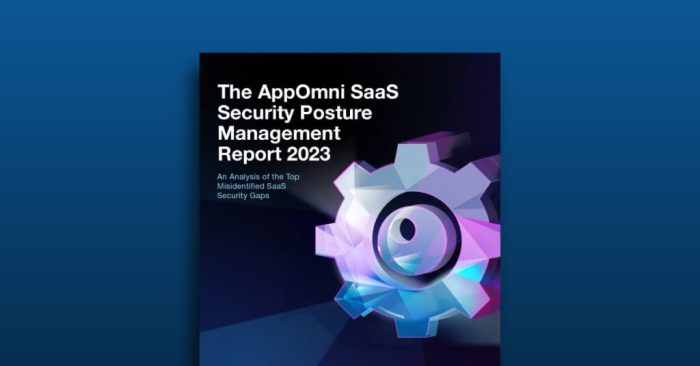
The AppOmni SaaS Security Report delves into the current state of SaaS security, revealing critical trends and insights that highlight the evolving landscape of threats and vulnerabilities in the cloud. The report analyzes data from thousands of organizations across various industries, providing a comprehensive view of the challenges and opportunities in securing SaaS applications.
Prevalence of SaaS Security Breaches
The report highlights a significant increase in the frequency and severity of SaaS security breaches. Organizations are increasingly reliant on SaaS applications for critical business operations, making them prime targets for cybercriminals.
The report found that 75% of organizations experienced at least one SaaS security incident in the past year.
This statistic underscores the growing vulnerability of organizations to SaaS security threats. The increasing adoption of SaaS applications, coupled with the lack of comprehensive security measures, creates a fertile ground for attackers.
The AppOmni SaaS security report highlighted some crucial vulnerabilities in popular cloud applications. It’s a reminder that even the most secure services can be susceptible to breaches, which is why considering a robust password manager like LastPass is vital.
When deciding between LastPass Premium and its free version, check out this comparison lastpass premium vs free to determine which best suits your needs. Ultimately, a strong password manager, combined with the insights from the AppOmni report, can significantly bolster your overall security posture.
The Importance of a Multi-Layered Security Approach
The report emphasizes the need for a multi-layered security approach to effectively protect SaaS applications. Traditional security measures, such as firewalls and intrusion detection systems, are no longer sufficient to address the complexities of the modern cloud environment.
The AppOmni SaaS Security Report highlighted some serious vulnerabilities in popular cloud applications, reminding us of the importance of robust security measures. While we’re tackling those issues, I can’t help but be distracted by the news that the Brown Thomas Marvel Room has arrived! It looks incredible , and I’m already planning a visit.
Back to the AppOmni report though, I’m definitely going to be reviewing our own security practices in light of their findings.
The report recommends a layered approach that includes access control, data loss prevention, threat intelligence, and continuous monitoring.
This comprehensive strategy addresses various security challenges, including unauthorized access, data exfiltration, and insider threats. Organizations need to adopt a holistic security posture that encompasses all aspects of their SaaS ecosystem.
The Growing Threat of Insider Threats
The report sheds light on the increasing threat posed by insider threats. Employees, contractors, and other insiders can inadvertently or intentionally compromise SaaS applications, leading to data breaches and other security incidents.
The report found that 25% of SaaS security breaches were attributed to insider threats.
This alarming statistic highlights the need for robust identity and access management (IAM) solutions. Organizations must carefully control access to sensitive data and applications, ensuring that only authorized individuals have the necessary privileges.
The Importance of Continuous Monitoring and Response
The report emphasizes the importance of continuous monitoring and response to effectively detect and mitigate SaaS security threats. Organizations must actively monitor their SaaS applications for suspicious activity, proactively identify vulnerabilities, and respond promptly to incidents.
The report recommends implementing a comprehensive security information and event management (SIEM) solution for real-time monitoring and incident response.
This proactive approach enables organizations to detect threats early, prevent breaches, and minimize the impact of security incidents.
Best Practices for SaaS Security
The AppOmni SaaS Security Report highlights critical vulnerabilities and attack vectors prevalent in today’s SaaS landscape. Based on these findings, we can identify key best practices to enhance the security posture of your SaaS applications. Implementing these practices will help organizations mitigate risks, protect sensitive data, and ensure business continuity.
Implementing a Robust SaaS Security Strategy
A comprehensive SaaS security strategy is crucial for protecting your organization’s data and applications. This strategy should encompass a range of security controls, including:
- Access Management:Implementing robust access control measures is fundamental for securing your SaaS applications. This involves:
- Least Privilege Principle:Granting users only the minimum access required to perform their job responsibilities. This minimizes the potential impact of a compromised account.
- Multi-Factor Authentication (MFA):Implementing MFA for all user accounts, including administrators, adds an extra layer of security by requiring multiple forms of authentication.
- Regular Access Reviews:Periodically reviewing user access permissions to ensure they are still necessary and appropriate.
- Data Security:Protecting sensitive data stored within SaaS applications is paramount. This includes:
- Data Encryption:Implementing data encryption at rest and in transit to safeguard sensitive information.
- Data Loss Prevention (DLP):Utilizing DLP solutions to detect and prevent unauthorized data exfiltration.
- Data Masking:Replacing sensitive data with non-sensitive values for testing and development purposes.
- Security Awareness Training:Educating employees about SaaS security best practices is essential for preventing security incidents. This includes:
- Phishing Awareness:Training employees to recognize and avoid phishing attempts.
- Strong Password Practices:Encouraging the use of strong, unique passwords for all accounts.
- Security Policies and Procedures:Communicating clear security policies and procedures to all employees.
- Threat Monitoring and Incident Response:Continuously monitoring for threats and having a robust incident response plan in place is critical for minimizing the impact of security incidents. This includes:
- Security Information and Event Management (SIEM):Implementing a SIEM solution to collect and analyze security events.
- Security Monitoring Tools:Utilizing security monitoring tools to detect suspicious activity and potential threats.
- Incident Response Plan:Having a well-defined incident response plan to guide the organization’s response to security incidents.
SaaS Security Tools and Technologies
Leveraging dedicated SaaS security tools and technologies can significantly enhance your organization’s security posture. These tools can automate security tasks, provide comprehensive visibility into your SaaS environment, and detect and respond to threats more effectively.
- SaaS Security Posture Management (SSPM):SSPM solutions provide centralized visibility and control over your SaaS applications. They can automate security tasks, identify vulnerabilities, and enforce security policies.
- Cloud Access Security Broker (CASB):CASBs act as a security gateway between your organization’s network and SaaS applications. They can enforce security policies, monitor user activity, and protect sensitive data.
- Security Information and Event Management (SIEM):SIEM solutions collect and analyze security events from various sources, including SaaS applications. They can detect suspicious activity and provide insights into potential threats.
- Vulnerability Scanners:Vulnerability scanners can identify security vulnerabilities in your SaaS applications. They can help you prioritize remediation efforts and improve your overall security posture.
Adopting a Zero Trust Approach, Appomni saas security report
A zero-trust security model assumes that no user or device can be trusted by default. This approach requires organizations to verify the identity of every user and device before granting access to resources. Implementing a zero-trust approach for SaaS applications can significantly reduce the risk of unauthorized access and data breaches.
Best Practices for SaaS Security
| Practice | Description | Benefits | Implementation Steps |
|---|---|---|---|
| Least Privilege Principle | Granting users only the minimum access required to perform their job responsibilities. | Reduces the potential impact of a compromised account, minimizes the risk of unauthorized data access, and improves overall security posture. |
|
| Multi-Factor Authentication (MFA) | Requiring users to provide multiple forms of authentication before accessing SaaS applications. | Adds an extra layer of security to user accounts, making it more difficult for unauthorized individuals to gain access. |
|
| Data Encryption | Encrypting sensitive data both at rest and in transit to protect it from unauthorized access. | Protects data from unauthorized access even if the SaaS provider’s infrastructure is compromised. |
|
| Security Awareness Training | Educating employees about SaaS security best practices and threats. | Reduces the risk of human error and helps employees make informed decisions about security. |
|
| Regular Security Audits | Conducting regular security audits to identify vulnerabilities and ensure compliance with security standards. | Identifies security weaknesses and helps organizations improve their security posture. |
|
| Incident Response Planning | Developing a comprehensive incident response plan to guide the organization’s response to security incidents. | Minimizes the impact of security incidents and helps organizations recover quickly. |
|
The Future of SaaS Security
The landscape of SaaS security is constantly evolving, driven by the rapid adoption of cloud services and the emergence of new threats. Understanding the future of SaaS security is crucial for businesses to stay ahead of the curve and protect their sensitive data.
Emerging Trends and Technologies
The future of SaaS security is shaped by several emerging trends and technologies. These advancements offer new opportunities for businesses to strengthen their security posture while also presenting unique challenges.
- Zero Trust Security:This approach assumes no user or device can be trusted by default. It emphasizes continuous authentication and authorization, access control based on context, and strong data encryption. Implementing Zero Trust principles in SaaS environments can significantly enhance security by reducing the attack surface and limiting the impact of breaches.
For example, a company might use Zero Trust to restrict access to sensitive data based on the user’s location, device type, and the time of day. This ensures that only authorized users can access critical information, even if their credentials are compromised.
- SASE (Secure Access Service Edge):This framework combines network security functions like firewalls and VPNs with cloud-based security services like data loss prevention and threat intelligence. SASE enables secure access to cloud applications from any location, simplifying security management and improving user experience. By centralizing security controls, SASE makes it easier for organizations to enforce consistent policies across their entire SaaS ecosystem.
- Cloud Security Posture Management (CSPM):This technology helps organizations assess and manage their cloud security risks. CSPM tools continuously monitor cloud configurations, identify misconfigurations, and provide recommendations for remediation. They can also help organizations comply with relevant regulations and industry standards. CSPM plays a vital role in maintaining a secure cloud environment by proactively identifying and addressing vulnerabilities.
- Artificial Intelligence (AI) and Machine Learning (ML):These technologies are transforming the field of cybersecurity. AI and ML can be used to detect and respond to threats in real-time, analyze large volumes of data for anomalies, and automate security tasks. They can also be used to improve threat intelligence and predict potential attacks.
For example, AI can analyze user behavior patterns to detect suspicious activity and flag potential threats.
- Serverless Computing:This technology allows developers to run code without managing servers, reducing operational overhead and increasing scalability. However, serverless environments also present new security challenges, such as the need for secure code development practices and vulnerability management. Organizations need to adopt security measures specifically designed for serverless architectures to mitigate these risks.
Impact on Businesses and Organizations
These emerging trends and technologies have a profound impact on businesses and organizations, both in terms of opportunities and challenges.
- Enhanced Security Posture:By adopting these advancements, businesses can significantly improve their security posture and reduce the risk of data breaches. This translates into increased customer trust, reduced operational costs, and better compliance with regulatory requirements. For example, a company that implements Zero Trust principles can minimize the impact of a phishing attack, even if an employee clicks on a malicious link.
- Improved Efficiency and Scalability:These technologies streamline security operations and improve efficiency. For example, AI-powered security solutions can automate repetitive tasks, allowing security teams to focus on more strategic initiatives. This improved efficiency also enables businesses to scale their security operations as their SaaS usage grows.
- New Security Challenges:The adoption of new technologies also brings new security challenges. For example, serverless computing requires a different approach to vulnerability management. Organizations need to invest in training and resources to effectively manage these challenges.
- Increased Complexity:The increasing complexity of the cloud environment can make it difficult for organizations to manage security effectively. Businesses need to adopt a comprehensive approach to SaaS security, leveraging a combination of technologies and best practices.
Predictions for the Future of SaaS Security
The future of SaaS security is bright, with continued advancements in technology and a growing focus on security best practices.
- Increased Adoption of Zero Trust Security:Zero Trust security is expected to become the standard approach for securing SaaS environments. This shift will be driven by the growing awareness of the need for more robust security measures and the increasing availability of Zero Trust solutions.
- Greater Integration of AI and ML:AI and ML will play an increasingly important role in SaaS security, enabling organizations to automate security tasks, improve threat detection, and respond to threats in real-time.
- Increased Focus on Data Security:As businesses increasingly rely on SaaS applications to store and process sensitive data, the focus on data security will intensify. Organizations will need to adopt robust data encryption and access control measures to protect their data.
- Emergence of New Security Solutions:As the SaaS landscape evolves, new security solutions will emerge to address emerging threats and challenges. These solutions will be tailored to specific SaaS applications and cloud environments, providing more targeted and effective protection.


